A light-hearted look at who gets to name the new “discovery” by the British sketch comedy team, David Mitchell and Robert Webb.
As reported by Slate Magazine: Scientists have discovered a trippy scene under the Red Sea, full of fluorescent, glowing corals. An international team of researchers discovered the colorful corals at depths of more than 150 feet below the surface and published their findings in PLOS ONE.
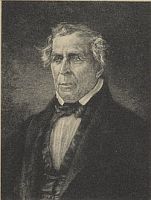
Preserved Fish
Puritans were notorious for weird names. Some first names are strangely long, such as “If-Christ-had-not-died-for-thee-thou-hadst-been-damned” or “Fight-the-good-fight-of-faith”. Some names were short but just disturbingly odd. Fly-fornication, for example. In 1766, Preserved Fish was born in Portsmouth, Rhode Island. His first name, Preserved, pronounced “pre-SER-vedd” is thought to be a shortening of “Preserved in Grace” or “Preserved from Sin.”
As a young man, Preserved shipped out on a whaling ship on a voyage to the Pacific. At 21, he became a whaling ship captain. When he came ashore, he became a successful merchant in first New Bedford and then New York City. He founded the shipping firm, Fish & Grinnell. He later became one of the 28 brokers of the New York Exchange Board, which later became the New York Stock Exchange and also became a director of Bank of America. He also served until his death as President of the Tradesman’s Bank. His family, which remained prominent in New York, also gave rise to Hamilton Fish, governor, senator, and secretary of state, and Stuyvesant Fish, a notable railroad president.
Preserved Fish has not entirely been forgotten. Singer/songwriter Ken Ficara immortalizes Preserved Fish with a song by the same name. The lyrics are below. Click here to listen to Ken singing his song.
 The 61′ high 11 ton inflatable Giant Rubber Deck, featured in the Philadelphia-Camden Tall Ships Festival 2015, had some problems in the “Parade of Ships” on Thursday. The duck was being towed on a pontoon, which was found to have holes and was sinking, causing the duck to become unstable. Initial reports said that the duck was undamaged but later accounts suggest that the duck was damaged and leaking and has been taken ashore repairs. With luck, festival-goers will be so involved with incredible fleet of tall ships tied up along the banks of the Delaware River that they will not notice the absence. Thanks to Robert Rustchak of the Philadelphia Ship Preservation Guild and the tall ship Gazela, for passing along his sister-in-law’s photo of the droppy duck.
The 61′ high 11 ton inflatable Giant Rubber Deck, featured in the Philadelphia-Camden Tall Ships Festival 2015, had some problems in the “Parade of Ships” on Thursday. The duck was being towed on a pontoon, which was found to have holes and was sinking, causing the duck to become unstable. Initial reports said that the duck was undamaged but later accounts suggest that the duck was damaged and leaking and has been taken ashore repairs. With luck, festival-goers will be so involved with incredible fleet of tall ships tied up along the banks of the Delaware River that they will not notice the absence. Thanks to Robert Rustchak of the Philadelphia Ship Preservation Guild and the tall ship Gazela, for passing along his sister-in-law’s photo of the droppy duck.
The Philly giant inflatable duck been the subject of some controversy. The Dutch artist Florentijn Hofman who created sculpture named “Spreading Joy Around the World” but universally known simply as “Rubber Duck,” is charging that the Philly duck is an “unauthorized rubber duck project.” Various incarnations of the rubber duck have appeared at over 20 locations around the globe.
This post is not quite nautical, but it does involving sailing. The Planetary Society, a non-government, nonprofit organization, is sending sailing ships out to explore space, sailing on the light of the sun. The first prototype completed a generally successful test mission earlier this month. A larger 32 square meter LightSail is scheduled to be launched in 2016. The project is being funded by a Kickstarter campaign.
If you are in the neighborhood, stop by the Cutter Lilac on Saturday for the Artist’s Midsummer Party at the Hudson River Park’s Pier 25. The ship opens to visitors at 2:00 PM. The party is from 6:00 – 9:00 PM.

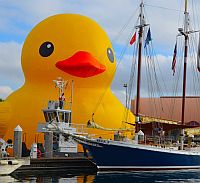
Photo: Craig Samborski
In addition to a fleet of tall ships attending the Philadelphia-Camden Tall Ships Festival 2015, there will be a 61-foot tall, 11-ton inflatable rubber duck. The duck is said to be based on a the plans for a inflatable sculpture originally made by Dutch artist Florentijn Hofman named “Spreading Joy Around the World” but universally known simply as “Rubber Duck.” While the rubber duck has indeed been spreading joy around the world, appearing at over 20 locations around the globe, the artist is not happy about this rubber duck. Hoffman is charging that this is an “unauthorized rubber duck project.” Is the Philly Rubber Duck an imposter?
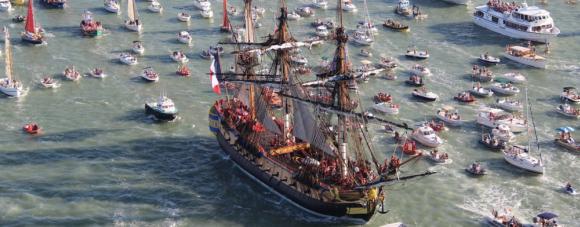 The Philadelphia-Camden Tall Ships Festival running from June 25-28th, promises to be something special. I am sorry that I will be out of town and will miss the festivities. The events begin on Thursday, June 25, with a “Parade of Ships” up the Delaware, starting around 1 PM and continuing all afternoon, as the more than 16 tall ships arrive on the Philadelphia and Camden waterfronts. Headlining the tall and historic ships will be l’Hermione as she continues her tour of the East Coast. l’Hermione is a replica of the 145-foot long Concorde class frigate that brought General Lafayette to the aid of the fledgling United States during the Revolutionary War. l’Hermione will be docked just outside the Independence Seaport Museum.
The Philadelphia-Camden Tall Ships Festival running from June 25-28th, promises to be something special. I am sorry that I will be out of town and will miss the festivities. The events begin on Thursday, June 25, with a “Parade of Ships” up the Delaware, starting around 1 PM and continuing all afternoon, as the more than 16 tall ships arrive on the Philadelphia and Camden waterfronts. Headlining the tall and historic ships will be l’Hermione as she continues her tour of the East Coast. l’Hermione is a replica of the 145-foot long Concorde class frigate that brought General Lafayette to the aid of the fledgling United States during the Revolutionary War. l’Hermione will be docked just outside the Independence Seaport Museum.
Also joining in the festival will be the USCG Barque Eagle; as well as El Galeon Andalucia, a replica of a late 16th Century fabled merchant vessel and warship; Philadelphia’s official Tall Ship Gazela; the world traveling barque Picton Castle, New Jersey’s tall ship A.J. Meerwald, and Portugal’s training ship Sagres, among other vessels. Click here for a more complete list of participating ships. Click here for more information and to buy tickets.
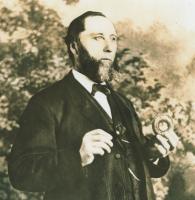
Captain Hansen Gregory
Some friends of mine think that I am crazy because I seem to find nautical connections in just about everything. (Other friends think I am crazy for other reasons.) Take for example, the modern donut. What about a donut could possibly have anything to do with sailors, ships or the sea? In fact, the development of the modern donut is usually attributed to Hansen Crockett Gregory, 1832-1921, a ship’s captain from Rockport, Maine. Here is the “hole” story.
The first donuts in America did not have holes. They are believed to have been introduced to the continent by the Dutch who fried dough in oil. Washington Irving was the first to mention doughnuts in “The History of New York” in 1807. We wrote, “[I]t was always sure to boast of an enormous dish of balls of sweetened dough, fried in hog’s fat, and called dough-nuts, or oly koeks: a delicious kind of cake, at present known scarce to this city, except in genuine Dutch families.”
In honor the summer solstice today, Summer Solstice by Moonlit Sailor, a Swedish post-rock instrumental group.
I remember when I was quite young, I asked the question, “Why is the ocean salty?” We had just visited my grandparents in Florida and I had discovered first hand just how salty the seawater in the Gulf of Mexico could be. I was told that salt dissolves in water and is carried to the oceans by rivers, so that over time the sea keeps getting saltier. It seemed like a good answer to me, so I moved on other questions.
Recently, however, I heard Robert Ballard, the famous oceanographer and underwater archaeologist of Titanic and Thresher fame, say that, until recently, oceanographers did not know why the ocean was salty. They didn’t know until 1979 to be exact. The problem is that the old explanation, that salt was carried in from the rivers, didn’t quite work. The chemistry of the oceans and the chemistry of the rivers were different enough to suggest that something else was going on. Here is Ballard explaining their discovery on National Geographic.

Model SS Cornubia
Today is Juneteeth, a commemoration of the abolition of slavery in the state of Texas, in particular, and in the Confederate states in general, one hundred and fifty years ago today.
On June 5, 1865, two Union Navy ships, USS Cornubia and USS Preston, steamed into Galveston harbor. Both ships had been captured from the Confederacy. USS Cornubia was a 210′ long British fast iron paddle steamer, purchased by Confederate agents as a blockade runner, renamed Lady Davis, and then captured by the Union Navy in 1863. USS Preston was a 170′ twin screw British blockade runner named Annie, captured in 1864. The ex-blockade runners carried Captain B. F. Sands with a detachment of Union troops to raise the United States flag over the federal customs house on the Texas island city. On June 18, 1865, Union General Gordon Granger arrived at Galveston Island with 2,000 federal troops and took full control.
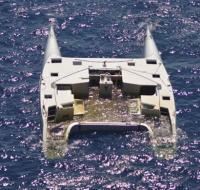 After five months, an abandoned catamaran has been sighted by a passing container ship. On January 30th of this year, Rainmaker, a brand new a $2.5 million carbon fiber Gunboat 55 catamaran, the first of its class, set off on a voyage from the Gunboat yard in North Carolina to St Martin in the Caribbean. Roughly 200 miles off the North Carolina coast, the boat dis-masted in a severe squall. The five crew were airlifted to safety by the Coast Guard and the boat was abandoned. Now five months later, the Hapag Lloyd container ship, Chicago Express, has spotted the derelict catamaran roughly 650 miles east of Cape Hatteras.
After five months, an abandoned catamaran has been sighted by a passing container ship. On January 30th of this year, Rainmaker, a brand new a $2.5 million carbon fiber Gunboat 55 catamaran, the first of its class, set off on a voyage from the Gunboat yard in North Carolina to St Martin in the Caribbean. Roughly 200 miles off the North Carolina coast, the boat dis-masted in a severe squall. The five crew were airlifted to safety by the Coast Guard and the boat was abandoned. Now five months later, the Hapag Lloyd container ship, Chicago Express, has spotted the derelict catamaran roughly 650 miles east of Cape Hatteras.
Sailing Anarchy reports that the container ship captain sent the following message:
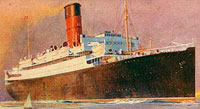 The tragic loss of an estimated 6,500 men, women and children on the Lancastria was covered up for more than seventy years. It was the greatest loss of life in the sinking of a single British ship, claiming more lives than the combined losses of the RMS Titanic and RMS Lusitania (1,200 passengers). Here is a repost from 2011, in honor of those lost on this day seventy five years ago. First posted October 2, 2011:
The tragic loss of an estimated 6,500 men, women and children on the Lancastria was covered up for more than seventy years. It was the greatest loss of life in the sinking of a single British ship, claiming more lives than the combined losses of the RMS Titanic and RMS Lusitania (1,200 passengers). Here is a repost from 2011, in honor of those lost on this day seventy five years ago. First posted October 2, 2011:
The evacuation of British troops and civilians from France in 1940 did not end with Dunkirk. Several weeks later, on June 17, 1940, the British Cunard liner Lancastria was loaded to capacity with troops and civilians off the French port of St. Nazaire, when she was struck by three direct hits from a German Junkers Ju 88 bomber. As many as 6,500 men, women, and children were lost when the ship sank. News of the disaster was covered up. Churchill said, “The newspapers have got quite enough disaster for today, at least.”
 Today’s “Google Doodle,” the changing graphic that appears at the top of the Google search page, is a whimsical memorial to the arrival of the Statue of Liberty in New York. “Google is celebrating America’s most famous gift from France today with a logo marking the Statue of Liberty’s arrival in the New York Harbor 130 years ago on June 17, 1885.”
Today’s “Google Doodle,” the changing graphic that appears at the top of the Google search page, is a whimsical memorial to the arrival of the Statue of Liberty in New York. “Google is celebrating America’s most famous gift from France today with a logo marking the Statue of Liberty’s arrival in the New York Harbor 130 years ago on June 17, 1885.”
Many sources put the arrival of the Statue of Liberty in New York as two days later on the June 19th. Likewise, the Google Doodle takes artistic license in showing the Statue of Liberty teetering on the deck of a tiny generic steam ship. So when and how did the Statue of Liberty arrive in New York?

Luisa Jo Killen
Not quite two years so, we posted about the death of the British folk and shanty singer who as born as Louis Killen. The post title was “Lou Killen, British Folk Song and Shanty Singer, Dies at 79.” Now after the Olympic gold-medalist Bruce Jenner has emerged as Caitlyn Jenner, I wonder where it would have been more respectful and appropriate to title the post, “Louisa Jo Killen….” In the last years of his life Lou became Louisa Jo. I don’t usually go back and change posts, but in this case I have.
As we posted in 2013 : In 2010, at the age of 76, Killen surprised friends and fans alike when he began living openly as a woman, performing in women’s clothing and a wig. In 2012, he underwent a sex-change operation. As noted in the New York Times: Adopting the name Louisa Jo Killen, she continued to perform for almost two years, by most accounts winning over most of Louis Killen’s fans and all of his friends.
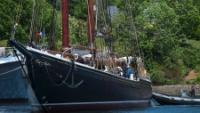 Millions over budget and years behind schedule, the Canadian schooner Bluenose II finally set sail last week from Lunenberg, Nova Scotia on a training sail. Bluenose II is owned by the government of Nova Scotia and will serve as a sailing ambassador for the province. While notionally a restoration and repair of the schooner Bluenose II built in 1963, the schooner is essentially new construction with new a keel, frames and planking and more modern scantlings. Originally budgeted at $14 million, the final cost will be over $20 million and may rise further. A $5 million claim with the shipyard has yet to be adjudicated. The new schooner is a near replica of the famous Nova Scotia fishing schooner Bluenose, built in 1921, which won a series of fishing schooner races in the 1920s and 1930s. Images of the schooner Bluenose have appeared on a Canadian stamp as well as on the current Nova Scotia licence plate and on the Canadian dime.
Millions over budget and years behind schedule, the Canadian schooner Bluenose II finally set sail last week from Lunenberg, Nova Scotia on a training sail. Bluenose II is owned by the government of Nova Scotia and will serve as a sailing ambassador for the province. While notionally a restoration and repair of the schooner Bluenose II built in 1963, the schooner is essentially new construction with new a keel, frames and planking and more modern scantlings. Originally budgeted at $14 million, the final cost will be over $20 million and may rise further. A $5 million claim with the shipyard has yet to be adjudicated. The new schooner is a near replica of the famous Nova Scotia fishing schooner Bluenose, built in 1921, which won a series of fishing schooner races in the 1920s and 1930s. Images of the schooner Bluenose have appeared on a Canadian stamp as well as on the current Nova Scotia licence plate and on the Canadian dime.
Bluenose II raises sail as captain readies vessel for service

Arctic Lamprey, Yukon River near Kaltag. (Randy Brown/USFWS)
The headlines are great. CBS News reports: Terrifying “vampire fish” falling from the sky in Alaska. Huffington Post chimes in: Hellacious Eel-Like Fish Are Dropping From The Sky In Alaska. The Washington Post offered, Why these mysterious, blood-sucking fish fell from the Alaskan sky.
It seems that live arctic lampreys were found on shore in Fairbanks Alaska, having apparently fallen from the sky. A rain of live fish is strange enough, but lampreys, over a foot long, look like something out a horror movie. They have a sucker-like mouth with five rows of teeth which they use to attach themselves to larger fish and other marine animals.
How these strange fish happen to fall from the sky? Alaska Department of Fish and Game information officer Nancy Sisinyak says that gulls likely picked up the fish in the nearby Chena River and then dropped them from their mouths mid-flight over the town. “When the fish wiggles free, and the bill scrapes the gills off the fish, it leaves a V-shape on either side,” Sisinyak said.
And how may fish have fallen from the sky? A grand total of four lampreys have been found ashore so far.
The Russian Sail Training Ship Kruzenshtern was maneuvering to depart the old harbor in Reykjavík, Iceland, yesterday, when she rammed two of the largest Icelandic Coast Guard vessels, Týr and Thor. Both ships suffered damage, although well above the waterline. There are no reports on damage to the Kruzenshtern.
STV “Kruzenshtern” collision in Reykjavik
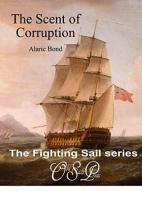 Alaric Bond’s latest novel, The Scent of Corruption, the seventh in the Fighting Sail series, is now available on Kindle and will soon be available in print. A great read.
Alaric Bond’s latest novel, The Scent of Corruption, the seventh in the Fighting Sail series, is now available on Kindle and will soon be available in print. A great read.
About the novel: Summer, 1803: the uneasy peace with France is over, and Britain has once more been plunged into the turmoil of war. After a spell on the beach, Sir Richard Banks is appointed to HMS Prometheus, a seventy-four gun line-of-battleship which an eager Admiralty loses no time in ordering to sea. The ship is fresh from a major re-fit, but Banks has spent the last year with his wife and young family: will he prove himself worthy of such a powerful vessel, and can he rely on his officers to support him?
With excitement both aboard ship and ashore, gripping sea battles, a daring rescue and intense personal intrigue, The Scent of Corruption is a non-stop nautical thriller in the best traditions of the genre.
